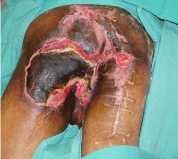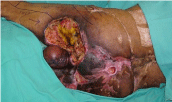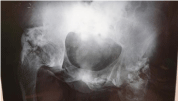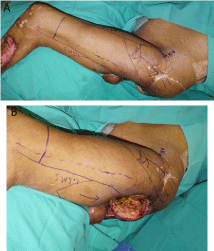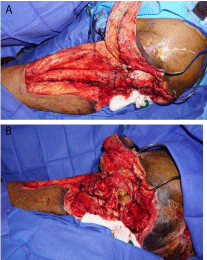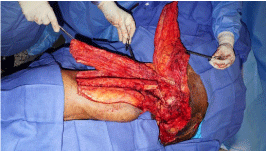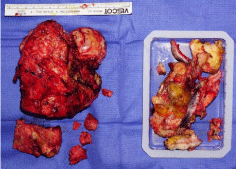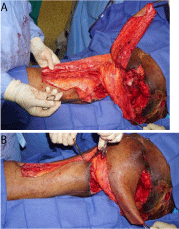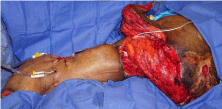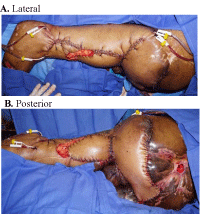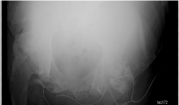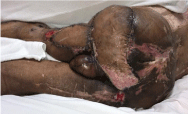Case Report
Complex Reconstructive Plastic Surgery for End Stage Pressure Ulcers in Spinal Cord Injury Patients
Caroline Yao, David Perrault and Salah Rubayi*
Division of Plastic and Reconstructive Surgery, University of Southern California, USA
*Corresponding author: Salah Rubayi, Division of Plastic and Reconstructive Surgery, Rancho Los Amigos National Rehabilitation Center, Keck School of Medicine of the University of Southern California, 7601 E Imperial Hwy, Downey, CA 90242, USA
Published: 03 Mar, 2017
Cite this article as: Yao C, Perrault D, Rubayi S. Complex
Reconstructive Plastic Surgery for End
Stage Pressure Ulcers in Spinal Cord
Injury Patients. Clin Surg. 2017; 2:
1325.
Abstract
The development of pressure ulcers is related to many factors. Primarily the lack of sensation and
unrelieved pressure resulting in ischemia of the tissue which eventually will progress to necrosis and
development of stage pressure ulcers. The worst is stage 3 & 4.
If proper wound care and patient education may help to heal these wounds but unfortunately in
spinal cord injury patients there is a high incident of recurrence of pressure ulcers, between 30-60%.
Therefore with the advancement of reconstructive plastic surgery this becomes possible to repair
the defect but there is a limitation to how many times using the same tissue or exhaustion of the
tissue available. We describe in this case how a spinal cord injury patient approached the final limit
of tissue available prior to final disarticulation. As a result a complex reconstructive surgery was
performed and described.
Introduction
Patients with spinal cord injury (SCI), pressure ulcers are a commonly encountered with a costly
problem. 27%-40% of those with SCI will develop a pressure ulcer during their initial hospitalization
and/or rehabilitation. Furthermore, the rates of re-hospitalization for pressure ulcer disease are
17.7% within the first year and 37.4% by 20 years post-injury [1]. The cost of treating pressure ulcers
in SCI patients has been reported as high as $1.2 billion per year in the United States, and is expected
to climb to 7.5 billion by 2020 [2].
Pressure ulcers are an especially serious complication in those with SCI. They are difficult to treat,
often recur, can impede rehabilitation, are socially isolating, and can result in devastating morbidity
and even mortality [3,4]. Because of the increasing longevity of patients with SCI, multiple recurrent
ulcerations and end-stage disease are more common [5]. “End-stage pressure ulcer patients” are often
described as those with recurrent ulceration, multiple failed flap reconstructions and Girdlestone
procedures [3]. Additionally, pressure ulcers are not typically an isolated complication of SCI. These
patients commonly suffer from a multitude of related conditions that exacerbate the pressure ulcer,
such as heterotopic ossification (HO) of the hip and pyogenic arthritis [6]. Therefore, treatment of
pressure ulcers in the end-stage patient should address all of the contributing problems.
There are both non-operative and operative modalities for pressure ulcer treatment. Nonoperative
management includes local wound care, negative pressure wound therapy (NPWT),
and electrical stimulation in select cases. Local wound care involves dressing changes and topical
antimicrobial, cleansing, and debriding agents. Negative pressure wound therapy has been used with
success, typically to improve primary wound healing in preparation for future soft tissue coverage
[7]. Electrical stimulation is beneficial when applied in combination with local wound care [8]. The
options for surgical treatment include debridement, skin grafting, flap coverage, the Girdlestone
procedure, or lower extremity disarticulation and total thigh flap coverage [3].
As reviewed by Kruger et al. the choice of treatment is guided by the stage and location of the
ulcer. When pressure ulcer has recurred and a patient has already undergone multiple reconstructive
flap procedures, options for wound healing become extremely limited. End stage ulcer patients
requiring surgery warrant special consideration, as previous flap incisions, previously harvested
skin/fascia/muscle and multiple medical comorbidities must be accounted for [3]. Finally, the
majority of soft tissue coverage options are typically exhausted for end-stage pressure ulcer patients
and surgeons must think creatively to construct surgical solutions. As such, we present a patient with
end-stage pressure ulcer disease treated with proximal femoral osteotomy and flap reconstruction
(the Girdlestone procedure). We also outline the important considerations when treating those with end-stage pressure ulcers with the modified Girdlestone procedure, as developed by the senior author.
Figure 1
Figure 1
Pre-surgical photograph, depicting stage IV sacrococcygeal,
perineal, bilateral ischial, and left posterior thigh pressure ulcers.
Figure 2
Figure 3
Figure 4a
Figure 4a
Planned surgical incisions: extended Tensor Fascia
Latafasciocutaneous flap. b.Planned surgical incisions: posterior thigh fasciocutaneous flap.
Figure 5A and B
Figure 5A and B
Surgical exposure of the femoral head, with the planned
transverse femoral osteotomy marked. Extended TFL fasciocutaneous flap has been raised.
Case Presentation
Our patient is a 61-year-old African-American male who
suffered incomplete T10 paraplegia secondary to spinal surgery
in 1997 for spinal stenosis. His medical comorbidities include
neurogenic bladder, hypertension, insulin-dependent type 2 diabetes,
hyperlipidemia, chronic anemia, lower extremity spasm, chronic
mixed essential tremor, and recurrent urinary tract infections. He
has had a colostomy and a suprapubic urinary catheter for several
decades.
He had received multiple flap surgeries since 2013 for pressure
ulcers as follows:
For recurrent sacral ulcers, he has received: a right lumbar
fasciocutaneous rotational perforator flap, a left gluteus V-Y sliding
island flap, and a right gluteus maximus myocutaneous rotational
flap that required re-rotation one year later. For recurrent bilateral
ischial ulcers, he has received: bilateral gracilis rotational muscle
flaps, bilateral medial thigh fasciocutaneous flaps, a right posterior
thigh fasciocutaneous rotational flap, and bilateral ischial osteotomies
for resection of osteomyelitis. For recurrent right trochanteric ulcers, he received: a right vastus lateralis rotational muscle flap and a right
rectus femorisrotational muscle flap. Despite previously healed flaps
and proper wheelchair cushioning in 2016, the patient developed
extensive stage IV sacrococcygeal, perineal, bilateral ischial, and left
posterior thigh pressure ulcers with localized gangrene soft tissue
infection (Figure 1).
The reason for developing these multiple pressure ulcers was
that patient admitted he sat too long without pressure relief. The
second important reason is the ankyloses of both hips secondary to
heterotopic ossification. In the previous flap surgeries patient refuse
to have a Girdlestone procedure. In this presentation, considering the
patient has a very limited muscle reserve, patient was advised that we may need to perform a disarticulation and total thigh flap to close the
present ulceration. Patient stated to leave this option as a last resort.
Operatively, in the first stage of the surgery, the patient was
placed in right lateral decubitus position and all necrotic tissue was
thoroughly debrided to healthy bleeding tissue (Figure 2). Given
the patient’s extensive soft tissue defect and heterotopic ossification
(Figures 2 and 3), the following combination of surgeries was
planned: left modified Girdlestone with excision of HO, with dead
space filled by rotational vastus lateralis with rectus femoris muscles,
and a combination of left tensor fascia lata extended rotational flap
and V-Y Hamstring advancement flap to close the skin.
In the second stage of the surgery, incisions were marked
for the extended Tensor Fasciae Lata (TFL) and posterior thigh
fasciocutaneous flaps adjacent to the wound. A line drawn between
the Anterior Superior Iliac Spine (ASIS) of the pelvis and anterior/
lateral patella was used plan the anterior incision. The intermuscular
septum was palpated and marked to plan the posterior incisions
(Figure 4). The flap measured 30 cm x 10 cm and was elevated as an
extended fasciocutaneous flap, including the distal gluteus maximus
muscle for vascular support.
The posterior incision of the TFL flap was used to access the
vastus lateralis muscle. The TFL fascia was incised sharply and the
intermuscular septum was identified along the entire length of the
vastus lateralis. The vastus lateralis, with the deep vastus intermedius,
was isolated posteriorly from the biceps femoris. Distally, the
vastus lateralis was horizontally divided where it became primarily
tendinous. We then divided the muscle flap along its anterior border.
The rectus femoris was included with the vastus lateralis muscle, as
additional volume was needed to fill the space of the wound. The entire group of muscles was elevated as a unit, using the femur as a deep border/landmark, taking care to protect the pedicle as the deep
dissection approached the proximal medial portion of the flap.
To expose the proximal femur, a transverse incision was made
over the origin of the vastus lateralis muscle 2 cm below the greater
trochanter. The vastus lateralis muscle fibers were dissected from the
proximal femur and the lateral attachment of the vastus lateralis to
the intermuscular septum was dissected and transected. Once bone
was exposed, Cobb elevators were used to protect the soft tissue
surrounding the femur and a transverse osteotomy was made below
the level of the lesser trochanter using an oscillating bone saw (Figure
5 and 6). The hip joint capsule was transected to expose the femoral
head. A Cobb elevator was inserted into the joint space to dislocate
the femur head from the acetabulum and the ligamentum teres was
transected. The head, neck, and greater and lesser trochanter of the
femur were removed en bloc (Figure 7). Remaining heterotrophic
ossification on the proximal femur was removed with a straight
osteotome. Sharp areas of bone were rasped until smooth.
The vastus lateralis muscle flap was rotated 90° counter-clockwise
to fill the ulcer defect and inset with 0-vicryl interrupted, buried
sutures (Figure 8). The TFL fasciocutaneous flap was rotated 90°
counter-clockwise and inset using 0-vicryl buried scarp as sutures
(Figure 8). Four drains were placed: 1 superior-lateral drain above the
vastus muscle flap, 1 superior-posterior drain below vastus muscle
flap, and 2 inferior drains along vastus harvest site (Figure 9). All skin was closed in a layered fashion, with 2-0 monocryl running external
interrupted, 0-PDS running external interrupted, and then staples
(Figure 10). Postoperative anteroposterior pelvic radiograph showed
excision of HO and the proximal osteotomy (Figure 11).
Figure 12 shows the patient at 4 weeks post-operatively, with all
flaps healing well. The distal aspect of the extended TFL fasciocutaneous
flap underwent superficial epidermolysis, which healed. The distalmost
aspect of these flaps must be closely monitored, as blood supply
is most tenuous in these areas.
Post operatively, the patient underwent the senior author’s
protocol of 6 weeks of bed rest in an air fluidized bed with hip
abduction pillow to allow for complete flap incision healing. At 6
weeks post-operatively, the patient began a gradual siting program
with a physical therapist [9].
Figure 6
Figure 6
Intraoperative photograph after transverse femoral head resection.
The grouped vastuslateralis and rectus femoris muscle flap and TFL
fasciocutaneous flapsare shown elevated.
Figure 7
Figure 7
Intraoperative photograph of the surgically resected specimens.
Note the large amount of heterotopic ossification about the head and neck of
the femur (Left) and the remaining heterotopic ossification that was removed
from the proximal femur (Right).
Figure 8
Figure 8
Isolated extended vastuslateralis with distal gluteus muscle
flaprotated to fill the acetabular cavity and wound base (A), followed
by coverage with the TFL fasciocutaneous flap and posterior thigh
fasciocutaneous flap (B).
Figure 9
Figure 10
Figure 11
Figure 11
Postoperative anteroposterior pelvis radiograph showing removed
heterotopic ossification and proximal osteotomy.
Figure 12
Figure 12
The patient 4 weeks post-operatively. Incisions were healing
well with no evidence of infection or wound breakdown. Area left open
infero-medially has nearly contracted to closure. Distal extended TFL
fasciocutaneous flap has superficial epidermolysis that is healing and closed.
Discussion
The Girdlestone procedure was first described by Dr.
Girdlestonein 1943. Initially, the procedure was presented as an
effective treatment for pyogenic arthritis of the hip [10]. Since that
time, it has additionally been shown to be an effective treatment for
end-stage pressure ulcers and heterotopic ossification of the hip in
spinal cord injury patients [6,10,11]. As previously reported, the
senior author has extensive experience treating end-stage pressure
ulcers and heterotopic ossification with a modified form of the
Girdlestone procedure [6]. Based on the senior author’s experience,
we present an overview of the most pertinent considerations when treating these patients.
The major distinctions of our modified Girdlestone procedure
include: filling of the dead space secondary to bony resection,
modifications to prevent femoral pistoning (proximal displacement
of femur), a larger femoral resection, and a single-stage technique [6].
The elimination of dead space has been recognized as important for
the outcome of this procedure since Girdlestone first described its use
[10]. Unfortunately, although Girdlestone took measures to “flatten”
the dead space, the original procedural technique often resulted in a
tissue defect after bony resection [6,10]. Filling of the bone defect with
vascularized tissue effectively mitigates wound healing and solves the
dead space problem [6].
Perforator based, fasciocutaneous, and musculocutaneous flaps
have all been shown to be effective as treatment options for pressure
sores; outcomes of pressure sores treated with these flap types have
been systematically reviewed and found to be equivalent in terms
of complication rates and recurrence [12]. In the experience of the
senior author, however, a pedicled rectus femoris muscle flap has
been especially favorable, given that this preserves the vastus lateralis
for later use [6].
As with elimination of the dead space, Girdlestone also noted that
preventing proximal displacement of the femur (femoral pistoning),
was vital in the post-operative care of these patients. Failure to
prevent muscle spasm and subsequent femoral pistoning will result
in detraction of the proximal femur from the surrounding muscle and
blood supply and, ultimately, impaired wound healing [3,6,10,13].
Girdlestone recommended placing the limb in traction with a
Hodgen splint or a plaster spica [10]. Since that time, more effective
methods have been developed, e.g. external fixation [13]. Notably,
however, the senior author has developed a less invasive technique
for preventing femoral pistoning by using anti-spasmodic medication
and an abduction pillow for 4 to 6 weeks post operatively, along with
physical therapy [11].
The senior author’s modifications to the Girdlestone procedure
also include resection of a larger segment of the femur than initially
described. Specifically, excising the head of the femur and greater
trochanter to a level below the lesser trochanter. This eliminates
all infected bone and functionally impairs the iliopsoas muscle by
releasing its tendinous attachment, therefore ameliorating long term
hip contractures and muscle spasms [6]. Decreasing the risk of hip
contractures is significant in SCI patients, asup to 44% have been
reported to develop at least one joint contracture at one-year post
SCI [14].
The senior author also strongly recommends treating or ensuring
adequate treatment of the chronic disease in end-stage pressure
ulcer patients. These patients have often lived for decades with SCI,
making anemia of chronic disease and hypoproteinemia with low
albumin and pre-albumin blood levels common. These factors, along
with more complex surgical needs, make end stage ulcer patients
particularly challenging to treat.
Further recommendations for the management of these patients
are a full nutritional workup, pre-operative cultures with sensitivities,
and comprehensive pre-surgical planning. The importance of
appropriate nutrition in spinal cord injury and pressure ulcer patients
is well known [16-18]. Nutritional workup and management should
include physical examination for signs of malnutrition, assay for
biomarkers of nutritional status (albumin, pre-albumin, transferrin,
nitrogen balance, creatinine, and total cholesterol), involve a
dietitian as part of the medical team, and follow the NPUAP-EPUAP
guidelines [3,18].
End stage pressure ulcers are often colonized with multiple
organisms, including those with drug resistance [15]. Additionally,
25% of those with pressure ulcers have underlying osteomyelitis [19].
A recent Cochrane review found that there is a paucity of data on
microbial colonization and infection in pressure ulcers [20]. However,
it is widely accepted that that controlling microbial colonization and
infection is important in the treatment of these patients. The senior
author recommends collecting pre-operative microbial cultures with
drug sensitivities.
Finally, pre-operative planning in these patients should
incorporate the previously harvested or rotated flaps. If pre-operative
records are not available, the scares from previous surgical incisions
can be used as a general clue of what has been done. It is also important
to consider the location of previous incisions as not to devascularize
the created skin islands.
There are many challenges in caring for end-stage pressure
patients. In addition to the mobility limiting result of SCI, these
patients have been reported to be subject to a large number of other risk
factors for developing pressure ulcers [2]. Furthermore, the number
of those with end-stage pressure ulcers appears to be increasing, likely
from improvements in long-term care. A systematic approach to the
treatment of these patients is highly important given the increasing
incidence of end-stage pressure ulcers and the complicated nature of
these patients. Our recommendations for the care of these patients
includes multidisciplinary care, including: a full nutritional workup,
pre-operative microbial cultures, careful pre-surgical planning,
control of any chronic disease, physical therapy, and soft tissue
coverage with boney resection as necessary, in conjunction with postoperative
anti-spasmodic medication, use of an abduction pillow for
4 weeks, and post-operative use of an air-fluidized bed for 4-6 weeks.
References
- Groah SL, Schladen M, Pineda CG, Hsieh CH. Prevention of Pressure Ulcers among People with Spinal Cord Injury: A Systematic Review. PMR. 2015; 7: 613-636.
- Byrne DW, Salzberg CA. Major risk factors for pressure ulcers in the spinal cord disabled: a literature review. Spinal cord. 1996; 34: 255-263.
- Kruger EA, Pires M, Ngann Y, Sterling M, Rubayi S. Comprehensive management of pressure ulcers in spinal cord injury: current concepts and future trends. J Spinal Cord Med. 2013; 36: 572-585.
- Regan MA, Teasell RW, Wolfe DL, Keast D, Mortenson WB, Aubut JA. A systematic review of therapeutic interventions for pressure ulcers after spinal cord injury. Arc Phys Med Rehabil. 2009; 90: 213-231.
- Rubayi S, Ambe MK, Garland DE, Capen D. Heterotopic ossification as a complication of the staged total thigh muscles flap in spinal cord injury patients. Anna Plast Surg. 1992; 29: 41-46.
- Rubayi S, Gabbay J, Kruger E, Ruhge K. The Modified Girdlestone Procedure with Muscle Flap for Management of Pressure Ulcers and Heterotopic Ossification of the Hip Region in Spinal Injury Patients: A 15-Year Review with Long-term Follow-up. Ann Plast Surg. 2016; 77: 645-652.
- Orgill DP, Bayer LR. Update on negative-pressure wound therapy. Plastic and reconstructive surgery. 2011; 127: 105s-115s.
- Lala D, Spaulding SJ, Burke SM, Houghton PE. Electrical stimulation therapy for the treatment of pressure ulcers in individuals with spinal cord injury: a systematic review and meta-analysis. Int Wound J. 2016; 13: 1214-1226.
- Rubayi S. Reconstructive Plastic Surgery of Pressure Ulcers. Springer Berlin; 2015.
- Girdlestone GR. Acute pyogenic arthritis of the hip: an operation giving free access and effective drainage. Clin Orthop Relat Research. 2008; 466: 258-263.
- Rubayi S, Pompan D, Garland D. Proximal femoral resection and myocutaneous flap for treatment of pressure ulcers in spinal injury patients. Ann Plast Surg. 1991; 27: 132-138.
- Sameem M, Au M, Wood T, Farrokhyar F, Mahoney J. A systematic review of complication and recurrence rates of musculocutaneous, fasciocutaneous, and perforator-based flaps for treatment of pressure sores. Plast Reconstr Surg. 2012; 130: 67e-77e.
- Klein NE, Luster S, Green S, Moore T, Capen D. Closure of defects from pressure sores requiring proximal femoral resection. Ann Plast Surg. 1988; 21: 246-250.
- Diong J, Harvey LA, Kwah LK. Incidence and predictors of contracture after spinal cord injury--a prospective cohort study. Spinal Cord. 2012; 50: 579-584.
- Rubayi S, Burnett CC. The efficacy of single-stage surgical management of multiple pressure sores in spinal cord-injured patients. Ann Plast Surg. 1999; 42: 533-539.
- Thomas DR. The role of nutrition in prevention and healing of pressure ulcers. Clin Geriatr Med. 1997; 13: 497-511.
- Pinchcofsky-Devin GD, Kaminski MV Jr. Correlation of pressure sores and nutritional status. J Am Geriatr Soc. 1986; 34: 435-440.
- Dorner B, Posthauer ME, Thomas D. The role of nutrition in pressure ulcer prevention and treatment: National Pressure Ulcer Advisory Panel white paper. Adv Skin Wound Care. 2009; 22: 212-221.
- Brown DL, Smith DJ. Bacterial colonization/infection and the surgical management of pressure ulcers. Ostomy Wound Manage. 1999; 45: 109S-118S.
- Norman G, Dumville JC, Moore ZE, Tanner J, Christie J, Goto S. Antibiotics and antiseptics for pressure ulcers. The Cochrane database of systematic reviews. 2016.

